Reading is fundamental (roundup)
1. A story on supermarket function and design from the New York Times, entitled "Turning Supermarkets Into Restaurants, Too" will hopefully help me make the case that supermarkets need to reconsider a lack of orientation to the street, to shift with the change in how people are thinking about supermarkets.
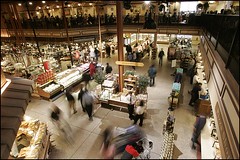 Photographer: Mark Finkenstaedt For the Washington Post. Wegmans Supermarket in Sterling Virginia offers customers elevated service and a complete line of lunchtime menus to suit almost any palate.
Photographer: Mark Finkenstaedt For the Washington Post. Wegmans Supermarket in Sterling Virginia offers customers elevated service and a complete line of lunchtime menus to suit almost any palate. 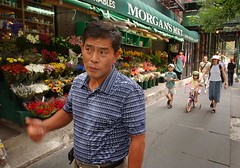 Grocery in Manhattan. Milwaukee Journal-Sentinel Photo/Mark Hoffman.
Grocery in Manhattan. Milwaukee Journal-Sentinel Photo/Mark Hoffman. 2. Speaking of supermarket design, a nice column (to be expected because she is one of the better urban design writers in the United States) from Whitney Gould of the Milwaukee Journal-Sentinel, "Big box need not be ugly" about a Copps grocery store in the Madison suburb of Middleton Hills, that has a pedestrian-centric entrance AND even 5 condos on top of the store.
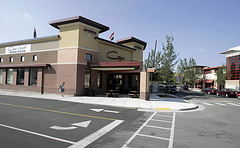 Copps store isn't perfect but a step forward. Photo/Rick Wood, Milwaukee Journal-Sentinel.
Copps store isn't perfect but a step forward. Photo/Rick Wood, Milwaukee Journal-Sentinel.I want to read the book Designing the World's Best Supermarkets for a concept paper I'm working on. I am heartened by the fact that Giant has retained a more urban design oriented firm to take a crack at their Cleveland Park store. I wonder if any of my back and forth communications to them had an impact -- see "People that care, but about different things." I haven't yet posted my email letter to Giant to the blog. I have to edit it and combine a couple different e-letters...
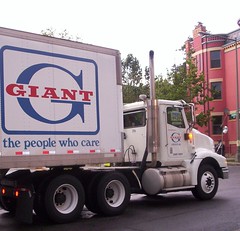
3. The Louisville Courier-Journal ran a five part series on urban housing issues. I don't know how long these stories will be accessible. Perhaps they will put them into their "Special reports" section. If you click through to "City hopes to replicate downtown housing success across Jefferson" you can access the full series. It's interesting because while the Louisville metro would be considered a relatively weak real estate market, suburban home building continues apace, and the area continues to deconcentrate. This series is about housing in the center part of the center city.
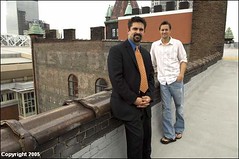 Living in Downtown Louisville. Photo by the Courier-Journal.
Living in Downtown Louisville. Photo by the Courier-Journal.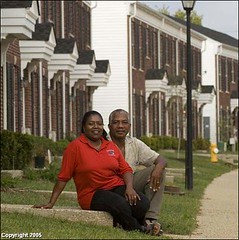 New condos in Louisville. Photo by the Courier-Journal.
New condos in Louisville. Photo by the Courier-Journal.4. "Prescott to make streets 'women friendly'" from the London Times is a provocative piece that encourages alternative thinking. Almost from the beginning of my involvement in Main Street commercial district revitalization I've made the point that since women conduct upwards of 80% of all retail transactions, unsavory commercial districts aren't likely to thrive. John King made the same point in an April column about Minneapolis. (Hmm, what is it about Wisconsin and Minnesota anyway?)
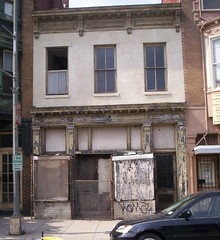 406 H Street NE, owned by prominent Greater Capitol Hill Realtor John Formant, is not "woman-friendly."
406 H Street NE, owned by prominent Greater Capitol Hill Realtor John Formant, is not "woman-friendly."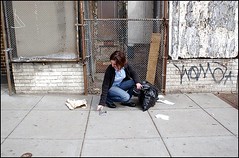 The same building as depicted in a story in the Washington Post about picking up trash on H Street. (Lauren Victoria Burke For The Washington Post)
The same building as depicted in a story in the Washington Post about picking up trash on H Street. (Lauren Victoria Burke For The Washington Post) In "Great architecture, clean streets, culture -- it must be Minneapolis," the ten points he makes dovetail nicely with the ideas and philosophy put forward by the Project for Public Spaces:
1. Street life thrives if you give it a chance.
2. Convenience isn't nearly as convenient as it seems.
3. The more [things to do] the merrier.
4. Culture adds spice.
5. Narrow streets are better than wide ones.
6. Play up the local angles.
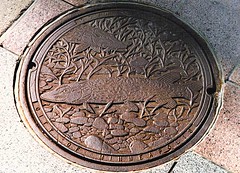 Minneapolis manhole cover makes the link between fishing and Minnesota's "10,000 lakes."
Minneapolis manhole cover makes the link between fishing and Minnesota's "10,000 lakes."7. Good architecture is good architecture, no matter the style.
8. Change is good.
9. Cleanliness counts.
10. Women know best.



0 Comments:
Post a Comment
<< Home